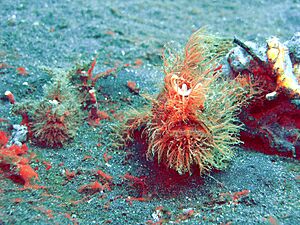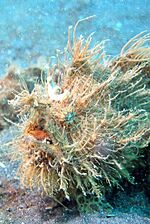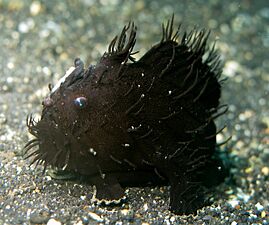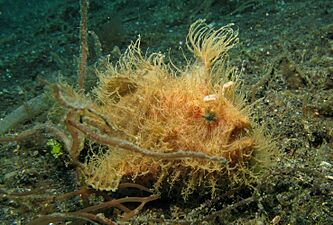Striated frogfish facts for kids
Quick facts for kids Striated frogfish |
|
|---|---|
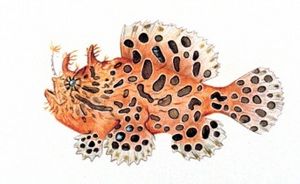 |
|
| Conservation status | |
| Scientific classification |
The striated frogfish or hairy frogfish (Antennarius striatus) is a special type of fish that lives in the ocean. It belongs to a group of fish called Antennariidae, which are known as frogfishes. You can find this fish in the Indo-Pacific and eastern Atlantic Ocean.
Contents
Meet the Striated Frogfish
The striated frogfish was first given its scientific name, Lophius striatus, in 1794 by an English scientist named George Shaw. He found it near Tahiti. This fish is part of a special group of frogfishes within the Antennarius family. Scientists place the Antennarius family with other anglerfishes in a larger group called Lophiiformes.
What's in a Name?
The name Antennarius comes from the word "antenna." This is because the frogfish has a special spine on its head that looks like an antenna. It uses this spine like a fishing rod to catch food!
The second part of its name, striatus, means "striped" or "streaked." This describes the many dark lines you can see on the fish's body.
Appearance and Camouflage
This small fish can grow up to 22 centimeters (about 8.5 inches) long. Like other frogfishes, it has a round body that can stretch. Its soft skin is covered with tiny bumps that look like hairs. It has a very large mouth that can stretch forward, allowing it to swallow prey as big as itself!
One of the coolest things about the striated frogfish is its amazing ability to change color. It can match its body color and patterns to its surroundings in just a few weeks. This helps it blend in perfectly with its home. Its colors can be yellow, orange, green, gray, brown, white, or even completely black. It might also have dark stripes or blotches on its body and fins.
Its Fishing Rod and Lure
The first spine on its back is very special. It's called an illicium and acts like a fishing rod. At the end of this "rod" is a worm-like lure. The frogfish wiggles this lure to attract other fish, which think it's a tasty worm!
This lure is a great way to tell the striated frogfish apart from a similar-looking fish called Antennarius hispidus. The "fishing rod" spine is about the same length as the second spine on its back and often has dark bands. The second spine stands straight up, and the third spine bends backward. These spines are separate from each other and from the main dorsal fin.
How It Moves
The frogfish's side fins (called pectoral fins) and belly fins (called pelvic fins) are angled. These fins help the frogfish "walk" along the sea bottom. They also help it stay still, waiting to ambush its prey.
Where They Live
You can find the striated frogfish in warm, tropical, and subtropical waters. They live in the Indian Ocean, the central Pacific Ocean, and parts of the Atlantic Ocean. This includes the western coast of Africa and the coast from New Jersey down to southern Brazil. They are also found in the Gulf of Mexico and the Caribbean. You won't find them in the Mediterranean Sea or the Arctic.
Their Home Environment
These fish live in shallow, sandy areas, or among rocks and coral reefs. They can be found from the surface down to 210 meters (about 690 feet) deep, but they are most often seen around 40 meters (about 130 feet) deep. They are masters of blending in, often looking just like the coral or sponges around them. This is called cryptic coloration.
However, rising ocean temperatures are causing problems for coral reefs. When oceans get warmer, their pH levels drop, making the water more acidic. This means less oxygen in the water and can lead to coral bleaching. Coral bleaching makes corals lose their color and die. Since frogfish rely on healthy, colorful corals to hide, bleached corals make them more visible to predators. Some frogfish, like Antennarius maculatus, have even turned white to match bleached corals.
Behavior and Hunting
Striated frogfish are very hungry carnivores. They will eat any right-sized prey that comes close, usually other fish. Sometimes, they even eat other frogfish! They can swallow prey that is as big as they are.
Like other frogfishes, they usually live alone on the sea bottom. They only come together during mating season. After mating, they go back to being solitary.
Unique Ways to Move
Frogfishes have a special way of moving. They take in water through their mouth and then push it out through small openings behind their side fins. This creates a jet-like push that moves them forward. Their body shape, with a large mouth and small gill openings, helps them do this. They can also "walk" along the ocean floor using their special side and belly fins. Since their fins aren't made for swimming, they usually stay on the bottom.
Defense Mechanisms
Besides blending in, frogfish have other ways to protect themselves. They can mimic other dangerous animals, like sea anemones, to scare away predators. For example, some frogfish can look like sea urchins resting on the floor. If a predator does find them, they can swell their bodies with water and stay inflated. This makes them too big and difficult for a predator to swallow.
Super Fast Eaters
Frogfish are amazing hunters. They don't have teeth. Instead, they use suction to inhale their food whole and alive! They can open their mouth very wide and quickly. They trick their prey by wiggling their lure in a way that looks like a small, struggling animal. Once the prey is close enough, the frogfish can suck it in in just six thousandths of a second!
The striated frogfish is one of the few frogfish species that also uses a special chemical to attract prey, especially at night when it's dark. When they are not hunting, they roll up their lure close to their body to protect it from predators. Some frogfish even have a special pocket to hide their lure.
Images for kids




